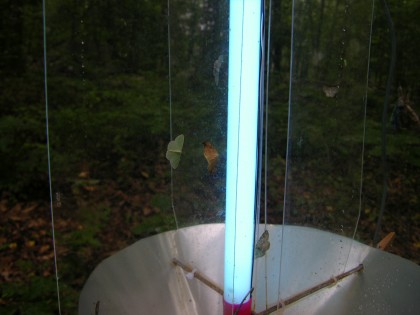
Our recently published study suggests that understory-dependent moths and butterflies might be disappearing from eastern forests (read a summary here) .
During field work, we conducted targeted searches for some of these understory-dependent species by finding their increasingly rare food plants. Once we found the plants, we either set a blacklight trap near the plant patch or searched the plants themselves for signs of caterpillars.
Searching the plants is particulalry productive for Papaipema moths because the caterpillars bore into plant stems and leave tell-tale signs of their presence. These signs includes tiny holes on stems and the sickly look of individual plants harboring caterpillars.
Despite targeted searches, many of the moths and butterflies we were looking for in the understory never appeared. In some cases we had quite a bit of trouble even finding these food plants.
Here’s a tour of some of the plants that were part of our searches:
Above is the Ten-Petal Sunflower (Helianthus decapetalus). We did find the moth that specializes on this forest sunflower, Papaipema rigida.
Stoneroot, Collinsonia canadensis. This plant is host for three moth species. We found two out of three of them. Missing in action: Papaipema duplicata.
False foxgolove, Aureolaria flava. A moth we did not find, Pyrrhia aurantiago, feeds on the developing seeds of this plant as a caterpillar.
New Jersey Tea, Ceanothus americana. This shrub was once considered “frequent” in our study area, but it is now scarce. So scarce that the two moths and one butterfly that specialize on it never turned up in our sampling.
The mottled dusky wing (Erynnis martialis), MIA New Jersey tea specialist
Beaked hazel, Corylus cornuta. This was also once considered very common. It it still quite common, but we rarely found this shrub above ankle height. Deer must love to eat it. We failed to find the one specialist on this shrub. Corylus is also a great all-around food plant for generalist caterpillars, so its loss is felt by many – including caterpillar eating song birds. This lush example of beaked hazel was at a spot with constant human activity. I think that’s why this one got away with getting so big and bushy.
Here’s another shrub that was usually only ankle high, maple leaf viburnum (Viburnum acerifolium). It was also once a significant part of the shrub layer on the Kittatiny Ridge. We did detect all of the Viburnum specialist moths, but this could be because they were feeding on wetland viburnums. It seems to me that wetland shrubs are more resilient to browse compared with upland counterparts.
Lysimachia quadrifolia has one specialist and this one turned up. Lysimachia was pretty common in the woods during our work. It might not be as palatable deer as some other plants.
Hay-scented fern. Ferns are reknowned as winners in the understory when there are too many deer around. Deer hate to eat ferns, so the ferns eventually come to rule the understory. As a result, we detected all eight species of moth specializing on ferns. In addition, some moths feed on forest litter – something else deer don’t eat. We found all of the litter specialists as well.
Papaipema inquaesita. We found this one because it feeds on sensitive fern.
Below is a complete list of the understory plants that were part of our surveys, along with our success at finding the butterflies and moths that use them as host plants.